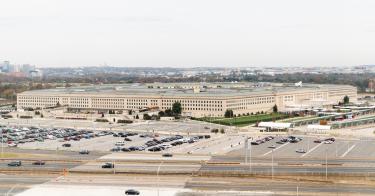When flooding damaged Offutt Air Force Base in Nebraska, some proclaimed it proof that climate change is a national security threat. Some perspective is needed.
Yes, extreme weather can damage military infrastructure. There are more than 7,000 facilities in the Defense Department’s portfolio and inevitably, storms will hit some of them in ways that impair training and operational readiness.
A January Defense Department report identified 79 military installations affected by weather-related events and notes that recurrent flooding, drought and wildfires will remain primary concerns for the next 20 years. No doubt other natural disasters like hurricanes and tornadoes present challenges as well.
No matter what the cause of these problems, it makes sense to prepare or adapt to them over time. If your home has flooded in the past or you live in tornado alley, you take the necessary action to reduce risk and protect your family. Whether it’s military or civilian infrastructure, safeguarding against current and future vulnerabilities with more durable infrastructure and innovative designs will mitigate risks and save lives.
Unsurprisingly, the military is doing just that. For example, that January report notes that, after “using a flood visualization tool to understand flooding impacts across the base,” Langley AFB determined where to “install door dams, which require less time and less labor than sandbags.”
Air Force bases in Florida are working with local groups to address coastal erosion and Navy Region Mid-Atlantic is working with state and local groups to protect against flooding, sea-level rise, and land subsidence.
In fact, the damage at Offutt may have been preventable. NBC reports that the base was made keenly aware of flooding risks when water came within 50 feet of a runway in 2011. They wanted to build higher levees but, the NBC report noted, “approval for the levee construction was complicated by myriad requirements from the Army Corps of Engineers that took six years to navigate.”
The moral of this story: The Pentagon should continue to identify vulnerabilities and make targeted investments to strengthen military installations. But onerous bureaucratic permitting processes should not stand in the way.
Nor should Congress impose “green” policies on the military that leave it less capable and prepared. For example, policymakers should not force the Pentagon to buy pricier renewable energy if no national-security justification exists.
We’ve been down that road before. It forced the Navy to pay $26 per gallon for biofuels, when it could have bought diesel for $3.60 per gallon. The Air Force bought 11,000 gallons of alcohol-to-jet fuel at $59 per gallon. These policies had no national security merit and chewed up resources that would have been better spent on training, modernization, and safeguarding infrastructure.
That is not to say that the Pentagon should not avail itself of alternative energy sources when it makes sense. For instance, solar photovoltaics can extend the range of drones. That’s an application that makes sense.
Not so sensible is playing the climate-change blame-game and fingering man-made emissions as the cause of extreme weather events and their resulting damage. For one thing, the science doesn’t support the accusation. The Intergovernmental Panel on Climate Changes 5th Assessment report and other mainstream science confirms that there is no significant trends toward more frequent or more violent extreme-weather events.
As for flooding in particular, the U.S. National Climate Assessment documents both increases and decreases in flood frequency.
“Trends in extreme high values of streamflow are mixed across the United States,” the report notes. “Analysis of 200 U.S. stream gauges indicates areas of both increasing and decreasing flooding magnitude but does not provide robust evidence that these trends are attributable to human influences.” It also concludes that there is no significant connection between human-induced warming and flooding.
The Defense Department should continue to identify vulnerabilities and make targeted investments to strengthen military installations. But politicizing the issue won’t make America’s military installations any safer.
This piece originally appeared in The Washington Times




